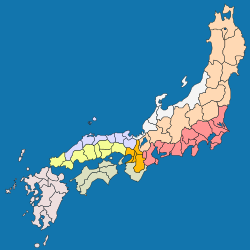Chūgoku region
The Chūgoku region (中国地方, Chūgoku-chihō), also known as the San'in-San'yō region (山陰山陽地方, San'in san'yō-chihō), is one of Japan's traditional regions.[1] The Japanese conventions of geography and history divide the nation into eight regions, including the Chūgoku region.[2] These have been used since 1905 as basic units for description and comparison[3] and as cultural markers.
The regions of Japan are a fusion of historical divisions and modern administrative needs".[4] The significance of the region in Japan is geographical, cultural and administrative.[5]
History
In the late 7th century, the San'indō and San'yōdō were identified as two of the eight largest administrative areas of the Imperial system (ritsuryo seido).
Gokishichidō is an ancient system of names for parts of the country, including San'indō and San'yōdō.[6] Chūgoku covers a western part of the island of Honshū[7] in roughly the same area as the traditional San'indō and San'yōdō.
In the Meiji period, the modern regional system was made by Imperial decree. Japan was divided into regions (chihō), including the Chūgoku region. A regional council (chihō gyōsei kyōgisai) was headed by the governor of the most powerful prefecture in the regional grouping. The council also included regional chiefs of central government ministries.[8]
Table: Chūgoku
Over time, Chūgoku has developed its own regional dialects, customs and unique traditional culture.[10]
Related pages
References
- ↑ Nussbaum, Louis-Frédéric. (2005). "Geography" in Japan Encyclopedia, p. 242; "Chūgoku", p. 127.
- ↑ Library of Congress Country Studies, Japan (LOC), "Geographic Regions"; "The islands of Hokkaido, Shikoku, and Kyushu each form a region, and the main island of Honshu is divided into five regions"; retrieved 2012-4-15.
- ↑ Tames, Richard. (2008). A traveller's history of Japan, p. 264.
- ↑ Japan Ministry of Foreign Affairs (MOFA), "Regions of Japan"; retrieved 2012-4-15.
- ↑ Brandt, Kim. Kingdom of Beauty: Mingei and the Politics of Folk Art in Imperial Japan, pp. 218-219;Shapira, Philip et al. (1994). Planning For Cities And Regions In Japan, p. 193, citing Research Institute of Construction and Economy. (1991). "Fig. 2-7. "Regional Vitalization and Construction Administration," White Paper on Construction; retrieved 2012-8-28.
- ↑ Nussbaum, "Goki-shichidō" at p. 255.
- ↑ LOC, "Chugoku"; retrieved 2012-4-15.
- ↑ Steiner, Kurt. (1965). Local Government in Japan, p. 62.
- ↑ 9.00 9.01 9.02 9.03 9.04 9.05 9.06 9.07 9.08 9.09 9.10 9.11 9.12 9.13 Titsingh, Isaac. (1834). Annales des empereurs du japon, p. 65 n3; Nussbaum, "San'in" at p. 817.
- ↑ Web-Japan.org, "Regions of Japan"; retrieved 2012-4-15.
Other websites
![]() Media related to Chūgoku region at Wikimedia Commons
Media related to Chūgoku region at Wikimedia Commons
Coordinates: 35°03′N 134°04′E / 35.050°N 134.067°E



